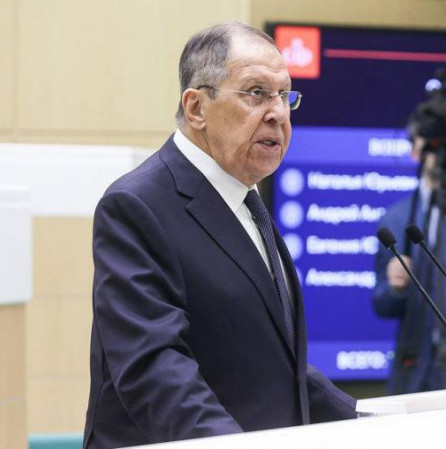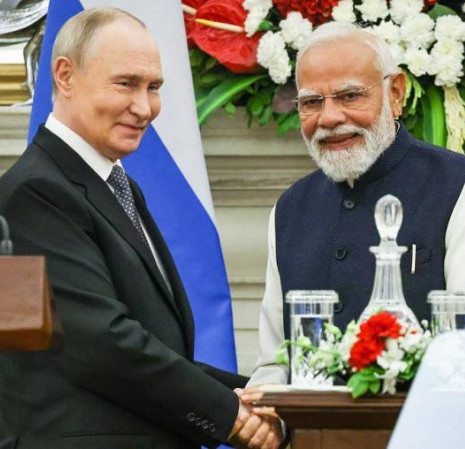The West is still discussing Russian President Vladimir Putin’s initiative to introduce a moratorium on Russia’s observance of the Conventional Forces in Europe Treaty (CFE). Moscow immediately came under ferocious criticism from the NATO leadership, the United States and Western media, all of which linked Russia’s possible withdrawal from the treaty to U.S. planned missile defense system deployment. The British and American press writes that the moratorium on the CFE is Moscow’s asymmetric answer to America’s intention to deploy elements of its missile defense in the Czech Republic and Poland. Earlier they demonstrated equal eagerness when announcing that Russia might respond by withdrawing from the Russian-U.S. Treaty on Medium and Short-Range Missiles. Let us try to understand what is behind this logic.
The CFE, the child of the Cold War and the following détente, concerned two powerful military and political alliances, NATO and the Warsaw Treaty Organization. The international treaty signed in 1990 envisaged bilateral reduction of heavy weapons, armored vehicles, attack helicopters, artillery and military units.
However, a year later the Warsaw Treaty broke up and so did the Soviet Union, the Soviet armed forces were pulled apart by its former republics, while its former allies began getting into NATO’s sphere of influence. Yet even during these dramatic developments Russia strictly abided by the Treaty, actually withdrawing all offensive arms from the European part of the country.
Military units at the Northern and Southern flanks lost most of their armored vehicles, attack helicopters and artillery systems. The Russian Armed Forces were subjected to endless NATO inspections, which checked whether the amount of tanks, infantry combat vehicles, self-propelled guns, armored tractors and fire support helicopters was in line with the set quotas. The problem became very acute after the counter-terrorist operation in Chechnya had begun, because Russia was unable to send the necessary reinforcement to the North Caucasus without coordination with its Western partners and, in fact, without their permission.
The situation within NATO was more favorable. Given that the alliance lagged behind the Warsaw Treaty Organization member states for the number of tanks, infantry combat vehicles, armored carriers and self-propelled guns, the CFE quotas allowed it to even increase its attack units. The situation deteriorated after NATO admitted new members and its military structures came closer to the Russian borders, but it was still not so dramatic as for Russia.
It became obvious that the old version of the CFE required serious adjustments. Corrections were made in Istanbul in 1999, at the summit of the Organization for Security and Cooperation in Europe (OSCE). The summit adjusted the parameters and configuration of the CFE, introduced and adjusted quotas on heavy weapons for new NATO member states, which were former members of the Warsaw Treaty, as well as for former Soviet republics, including Russia.
At that time, Russia managed to obtain NATO’s consent for an insignificant increase of heavy equipment at its northern and southern flanks. Yet the key restrictions for Moscow remained unchanged. Moreover, in the adjusted version Moscow undertook to withdraw its troops from Georgia and Moldova. Today, NATO links ratification of the adapted Treaty to this clause of the Istanbul agreements. The NATO member states will start ratification procedures only after Russian troops have withdrawn from Georgia and Moldova, which was once again confirmed by the alliance’s Secretary General Jaap de Hoop Scheffer immediately after Putin’s state of the nation address.
It should be specifically noted that no one in the West guarantees Russia that the decision will be positive in any case. NATO politicians and military offer general words about no one threatening Russia today, about NATO’s eastward expansion being purely peaceful and democratic and about deployment of new U.S. military bases in Bulgaria and Romania being related only to the Iranian nuclear problem.
Deploying its troops as it pleases, increasing strike units in South-East Europe, admitting the possibility of Georgia’s and Ukraine’s membership, NATO at the same time insists on Russia’s strict compliance with its commitments. Which Moscow has been doing unilaterally for about ten years now, seriously weakening its defense potential in the European part of the country.
All these years, Russia has repeatedly brought to Brussels’ attention that it is necessary that all NATO member states take steps to ratify the CFE in response. Usually it responded by tough demands that Russia withdraw its military from Georgia and Moldova. Yet even after the withdrawal began (now there are almost no large Russian units in the two former Soviet republics), there was no progress. Washington’s plans to deploy elements of its strategic weapons near the Russian borders only added fuel to the fire.
This is the complicated strategic backdrop against which Russia voiced its plans to introduce a moratorium on the CFE. Moscow no longer wants to disarm unilaterally, it does not want to watch passively while the configuration of the European security system is changing and it demands that Russia’s national interests be taken into account in Europe’s foreign policy. Russia does not want empty words and promises, it wants firm guarantees from its Western partners, wants to see their concrete steps towards fulfilling international arms treaties. Otherwise, the situation threatens to turn into a theater of the absurd, as has been rightly noted by Russian Foreign Minister Sergei Lavrov.
In this context, the president’s decision to introduce a moratorium on the CFE is not an asymmetric response to the U.S. missile defense system, but a systemic and well-considered approach to building fair and equal relations with NATO.
The CFE, the child of the Cold War and the following détente, concerned two powerful military and political alliances, NATO and the Warsaw Treaty Organization. The international treaty signed in 1990 envisaged bilateral reduction of heavy weapons, armored vehicles, attack helicopters, artillery and military units.
However, a year later the Warsaw Treaty broke up and so did the Soviet Union, the Soviet armed forces were pulled apart by its former republics, while its former allies began getting into NATO’s sphere of influence. Yet even during these dramatic developments Russia strictly abided by the Treaty, actually withdrawing all offensive arms from the European part of the country.
Military units at the Northern and Southern flanks lost most of their armored vehicles, attack helicopters and artillery systems. The Russian Armed Forces were subjected to endless NATO inspections, which checked whether the amount of tanks, infantry combat vehicles, self-propelled guns, armored tractors and fire support helicopters was in line with the set quotas. The problem became very acute after the counter-terrorist operation in Chechnya had begun, because Russia was unable to send the necessary reinforcement to the North Caucasus without coordination with its Western partners and, in fact, without their permission.
The situation within NATO was more favorable. Given that the alliance lagged behind the Warsaw Treaty Organization member states for the number of tanks, infantry combat vehicles, armored carriers and self-propelled guns, the CFE quotas allowed it to even increase its attack units. The situation deteriorated after NATO admitted new members and its military structures came closer to the Russian borders, but it was still not so dramatic as for Russia.
It became obvious that the old version of the CFE required serious adjustments. Corrections were made in Istanbul in 1999, at the summit of the Organization for Security and Cooperation in Europe (OSCE). The summit adjusted the parameters and configuration of the CFE, introduced and adjusted quotas on heavy weapons for new NATO member states, which were former members of the Warsaw Treaty, as well as for former Soviet republics, including Russia.
At that time, Russia managed to obtain NATO’s consent for an insignificant increase of heavy equipment at its northern and southern flanks. Yet the key restrictions for Moscow remained unchanged. Moreover, in the adjusted version Moscow undertook to withdraw its troops from Georgia and Moldova. Today, NATO links ratification of the adapted Treaty to this clause of the Istanbul agreements. The NATO member states will start ratification procedures only after Russian troops have withdrawn from Georgia and Moldova, which was once again confirmed by the alliance’s Secretary General Jaap de Hoop Scheffer immediately after Putin’s state of the nation address.
It should be specifically noted that no one in the West guarantees Russia that the decision will be positive in any case. NATO politicians and military offer general words about no one threatening Russia today, about NATO’s eastward expansion being purely peaceful and democratic and about deployment of new U.S. military bases in Bulgaria and Romania being related only to the Iranian nuclear problem.
Deploying its troops as it pleases, increasing strike units in South-East Europe, admitting the possibility of Georgia’s and Ukraine’s membership, NATO at the same time insists on Russia’s strict compliance with its commitments. Which Moscow has been doing unilaterally for about ten years now, seriously weakening its defense potential in the European part of the country.
All these years, Russia has repeatedly brought to Brussels’ attention that it is necessary that all NATO member states take steps to ratify the CFE in response. Usually it responded by tough demands that Russia withdraw its military from Georgia and Moldova. Yet even after the withdrawal began (now there are almost no large Russian units in the two former Soviet republics), there was no progress. Washington’s plans to deploy elements of its strategic weapons near the Russian borders only added fuel to the fire.
This is the complicated strategic backdrop against which Russia voiced its plans to introduce a moratorium on the CFE. Moscow no longer wants to disarm unilaterally, it does not want to watch passively while the configuration of the European security system is changing and it demands that Russia’s national interests be taken into account in Europe’s foreign policy. Russia does not want empty words and promises, it wants firm guarantees from its Western partners, wants to see their concrete steps towards fulfilling international arms treaties. Otherwise, the situation threatens to turn into a theater of the absurd, as has been rightly noted by Russian Foreign Minister Sergei Lavrov.
In this context, the president’s decision to introduce a moratorium on the CFE is not an asymmetric response to the U.S. missile defense system, but a systemic and well-considered approach to building fair and equal relations with NATO.



